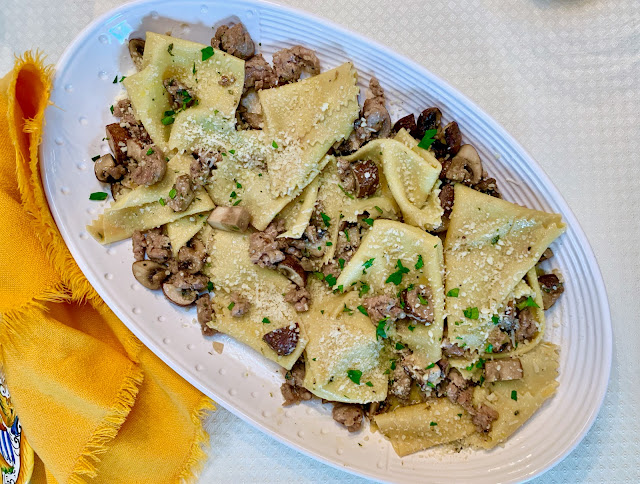The dough is made with OO flour, the gold standard when making pasta, with its fine, soft grain and high gluten content. I added two of the small glassine envelopes of saffron to the dough, after dissolving it in a tablespoon of warm water. And yes, you can taste the saffron in the pasta, although it is subtle. Dump everything into a food processor, leaving some of the flour aside because when you’re making an egg/flour pasta, it’s much easier to add more flour to a wet mixture than add more eggs to a dry pasta mixture. Feel free to mix it on the countertop, but you’ll need a lot more muscle. Even with the food processor, take it out and knead it on the counter, adding more flour if it’s too sticky, and kneading it until it’s as soft as a baby’s bottom. Cover it and set aside for at least a half hour, which gives the gluten time to relax and do its thing. It’ll be much easier to work with as a result.
This is the amount of pasta I made using the recipe below.
As you can see, I made about a dozen fazzoletti, that each measured 4″ x 4″, plus a lot of pappardelle that I plan to use in a separate recipe. Of course, you can always buy packaged pasta, or even fresh pasta in the refrigerated section, but you’ll have a hard time finding fazzoletti pasta, and there’s nothing quite so delicious as home made. I had a few scraps left over and cut them into thin spaghetti that I’ll most likely use in chicken soup.
The sauce comes together quite quickly, with some olive oil, herbs, sausage, shallots and mushrooms, all cooked in one pot.
Lift the cooked fazzoletti from the boiling water directly into the sauce, letting some of the water come along with it. Stir and mix everything together gently so you don’t rip the pasta. Add more of the pasta water, if needed.
Serve on a large platter, sprinkled with a drizzle of olive oil, some parmesan cheese and minced parsley.
Wait till you bite into this toothsome, yet silky pasta with these complementary flavors. If you’re like me, you’ll have a hard time stopping at one bowl.Click here to connect with me on Instagram and find out what’s cooking in Ciao Chow Linda’s kitchen each day (and more)
- FOR THE PASTA:
- 2 cups flour
- 4 eggs
- 2 packages (glassine envelopes) of saffron
- 1 tablespoon hot water
- FOR THE SAUCE
- 1 1/2 links of sweet Italian sausage (about 1/2 pound)
- 8-10 small portobello (or cremimi) mushrooms
- 1 shallot, minced
- 1 garlic cloves, minced
- 1/4 olive oil
- fresh sage leaves
- fresh thyme leaves
- salt, pepper
- minced parsley
- a little pasta water
- parmesan cheese
- Dissolve the saffron in the hot water.
- Place the flour (keep 1/2 cup of the flour aside) and eggs and the watered down saffron into a food processor (or mix by hand if you have the strength).
- If the dough is too sticky, add the rest of the flour, a little at a time.
- When the mixture has turned into a ball, remove to a wooden board.
- Knead a bit more (keeping flour on the board) until the dough is smooth.
- Shape it into a ball (or two balls) and wrap in plastic wrap, or keep covered under a bowl.
- Let the dough rest for a half hour.
- When ready to shape the dough, roll it by hand to a thin consistency, or using a pasta machine, roll it to the smallest number on the setting.
- For the fazzoletti, cut into 4 inch squares.
- This recipe makes a lot of fazzoletti, but you can shape some of it into fettuccine, or pappardelle or other shapes and reserve for other meals.
- I used 12 fazzoletti for two people and it was plenty for a meal.
- If you’re making it as a first course, you will want fewer fazzoletti for two people.
- Boil the fazzoletti in ample salted water and add to the sauce.
- FOR THE SAUCE;
- Add half the olive oil to a large saucepan.
- Heat to a medium heat, and add the sausage, crumbling it into pieces, and removing the casing.
- Wash the mushrooms and cut into quarters.
- Add the mushrooms to the sausage and when almost cooked, add the minced shallot and garlic.
- Add the fresh sage leaves and thyme leaves and let everything cook for about 10 minutes.
- Start cooking the fazzoletti in the boiling water.
- They should take only a few minutes to cook.
- Meanwhile, if the sauce looks too dry, add some of the pasta water.
- Drain the fazzoletti and add to the sauce.
- Don’t worry if some of the water comes along with it.
- Gently stir the pasta into the sauce, letting it absorb the flavors, and reducing the water.
- Season with salt and pepper.
- When the water is nearly all gone, add the rest of the olive oil.
- Toss gently into a serving bowl, and sprinkle with grated parmesan cheese and minced parsley,

















